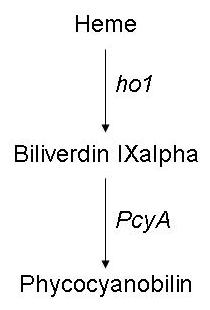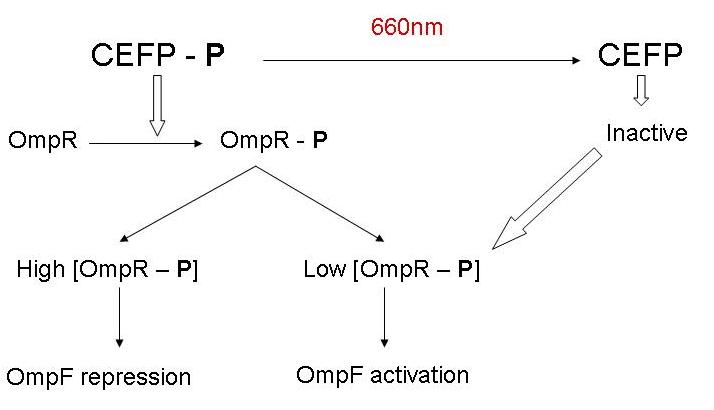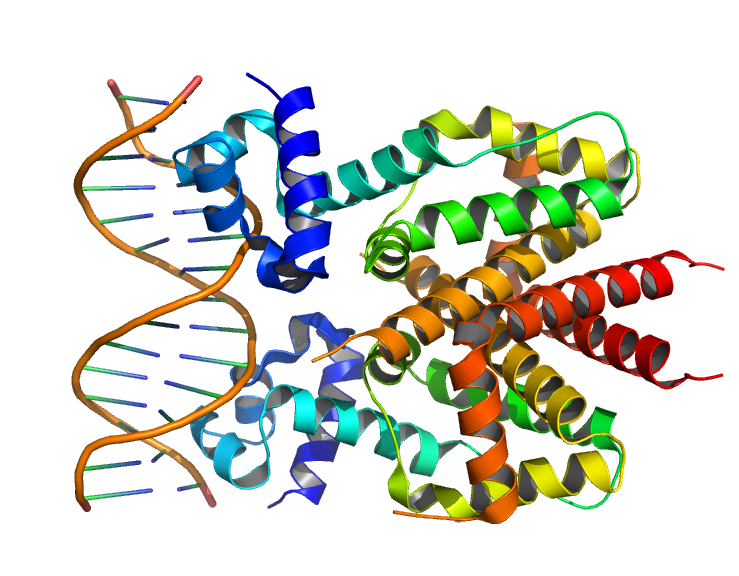Team:KULeuven/Project/Input
From 2008.igem.org
Contents |
Old Input
Searching for an input signal that was easily turned on and off, we chose to use the light-sensing device [http://partsregistry.org/Part:BBa_M30109 BBa_M30109]. This device has already been used by a number of teams, but for the sake of completeness, we describe it here again. We also gave it our own (working) number: [http://partsregistry.org/Part:BBa_K145011 BBa_K145011].
BioBricks
Components
The first step is to produce ho1 (heme oxigenase 1) that converts heme to biliverdin IXalpha. This enzyme is encoded by [http://partsregistry.org/Part:BBa_I15008 BBa_I15008]. The second step is to produce PcyA (phycocyanobilin:ferredoxin oxidoreductase) that converts the biliverdin IXalpha to phycocyanobilin. This enzyme is encoded by [http://partsregistry.org/Part:BBa_I15009 BBa_I15009]. This phycocyanobilin associates with the light receptive domain Cph1 of a Cph1/EnvZ fusion protein, encoded by [http://partsregistry.org/Part:BBa_I15010 BBa_I15010].
An extra need for the input mechanism is the presence of the TetR repressor. This molecule is encoded by part [http://partsregistry.org/Part:BBa_C0040 BBa_C0040], and contains an LVA tag for rapid degradation.
Action
The ho1 and PcyA coding parts are placed under a Pbad promoter ([http://partsregistry.org/Part:BBa_I13453 BBa_I13453]). As the AraC repressor is present in the cell, phycocyanobilin will only be made upon activation with arabinose. The coding part for the Cph1/EnvZ fusion protein is placed under control of a pTet promoter ([http://partsregistry.org/Part:BBa_R0040 BBa_R0040]). This means that, as TetR ([http://partsregistry.org/Part:BBa_C0040 BBa_C0040]), the Tet repressor, is present, the fusion protein will only be produced when aTc is added to the medium. This gives us the possibility to test the system with an exogenous memory instead of the endogenous one, which will then be added later on in the project (see here).
The Cph1 part of the Cph1/EnvZ fusion protein acts as the light sensor, the EnvZ part is a kinase. Upon radiation with 660nm (red) light, the fusion protein gets dephosphorylated. This renders the kinase in an inactive state. The active kinase phosphorylates the molecule OmpR. A high concentration of the phosphorylated ompR represses the OmpF promoter ([http://partsregistry.org/Part:BBa_R0084 BBa_R0084]). A lower concentration activates it. So when 660nm light is irradiated on the input mechanism, the concentration of phosphorylated OmpR drops and the OmpF promoter is turned on.
New Input
Doing some more searching around and after a couple of e-mails, we realised that [http://partsregistry.org/Part:BBa_M30109 BBa_M30109] caused a lot of problems for a lot of teams in 2007. That is why we decided to a more reliable, althought practically more difficult system.
BioBricks
Components
[http://partsregistry.org/Part:BBa_J23116 BBa_J23116] is a constitutive promotor, member of the BBa_J23xxx family promotors. The [http://partsregistry.org/Part:BBa_B0032 BBa_B0032] has an efficiency of 0,3 and [http://partsregistry.org/Part:BBa_B0015 BBa_B0015] is an efficient terminator. [http://partsregistry.org/Part:BBa_C0040 BBa_C0040] is a protein coding sequence that codes for the tetT repressor (see Figure). The [http://partsregistry.org/Part:BBa_R0040 BBa_R0040] promotors of Output, Memory and Filter are turned off by the constitutively produced tetR repressor protein. By adding anhydrotetracycline (aTc), the repressor protein can be disengaged from the operator sequence and the Output, Memory and Filter will be turned on.
 "
"







 Input
Input Output
Output Filter
Filter InverTimer
InverTimer Reset
Reset Cell Death
Cell Death Memory
Memory